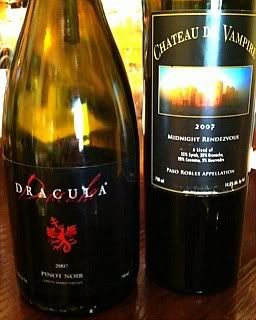Wine country is not a long drive from Los Angeles. In Southern California, though, drives have a way of becoming long even when they aren't supposed to be.
Wine Institute staged a wine tasting event on September 6, 2012, that left the driving to the wineries. The California Wine Road Trip tasting event brought the wines to Los Angeles. Actually, to the Peninsula Hotel in Beverly Hills. The Verandah Room - with its part outside, part inside design - is a great place for a wine tasting event, even on a hot and muggy afternoon.
Different California wine regions were laid out at their own tables, so one could get a glimpse of a whole region while standing still. Here are some highlights from my own tasting notes.
Lake County
Rosa D'Oro Vineyards Aglianico 2010 - A big, earthy, funky nose shows strong minerality. Great flavors of red fruit, candy finish and firm but smooth tannins.
Six Sigma Ranch Tempranillo 2008 - Tastes cherry delicious, with great acidity. Nice touch with the oak spice.
Livermore Valley
Fenestra Winery Pinot Gris 2010 - Earthy peach aromas, with minerals shading the fruit on the palate. Good acidity. Really nice touch of oak.
Mitchell Katz Winery Sangiovese 2010 - Smokey, rosy cherries all over the place. Great acidity.
Steven Kent Winery Lineage 2009 - A blend of Bordeaux grapes from the east end of Livermore Valley. Big fruit, very smooth, tart finish lasts forever. Steven Kent Mirassou said he had been on the road for several days, and the wine was just beginning to show like he wanted it to. It was showing very well.
Wente Vineyards Morning Fog Chardonnay 2010 - Pears, melons and apples. Oak just right. Great acid. 100 year-old vines. Wente claims to have done the first bottled Chardonnay in California.
Lodi
McCay Cellars Rosé 2011 - Carignane is the heart of this rosé. It's not done in the saignée method, where the juice is bled off in the making of a red wine. This is intended to be rosé all the way. The Carignane is picked from an old field blend vineyard where the grapes were conveniently laid in rows, more or less. Some Grenache, which imparts a bright cherry flavor, comes from a different vineyard. Michael McCay talked about micro climates and how the ocean cools an area 60 miles inland with breezes through the delta.
One of my favorite wines of the event.
Peltier Station Winery hy.brid Vermentino 2011 - Notes of the earth rather than the ocean, as is found in the Italian version of the grape. Nice acid, minerals.
Monterey
Bernardus Winery Fairview Pinot Noir 2009 - From Fairview Vineyard in the Santa Lucia Highlands. Subtle tannins.
Paso Robles
Austin Hope Wines Grenache 2010 - Brilliant fruit and acidity.
Justin Vineyards Icosoles 2009 - Extremely fruity nose, big dark fruit flavors and great tannins. Steak, please.
Villa Creek Cellars Rosé - Grenache, Counoise, Mourvedre and Roussanne combine for a smooth and refreshing wine. The acidity comes on the finish.
Tablas Creek Vineyard Cotes de Tablas Blanc 2010 - Fantastic minerals and salinity from a four-grape blend: Viognier, Grenache Blanc, Roussanne and Marsanne.
San Luis Obispo County
Tangent Winery Albarino 2011 - Great floral nose.
Zocker Winery Gruner Veltliner 2011 - Floral meets mineral on the nose, more minerals on the palate. Acidity really zips.
Saucelito Canyon Vineyard and Winery Cotes de Blanc 2011 - Roussanne, Marsanne and Grenache Blanc blend shows big minerals.
Santa Barbara County
Brewer-Clifton Chardonnay 2010 - Great, smokey oak bouquet, fruit forward and brilliant acidity. What more do you want?
Buttonwood Farm Winery Cabernet Franc 2009 - Beautiful red fruit and great acidity.
Foxen Winery Syrah 2010 - Great Rhone funk shows on the nose. Dark fruit, nice grip and a fabulous finish.
Margerum Wines M5 2009 - Doug Margerum adds Counoise and Cinsault to the standard GSM mix and gets an herbal wave over red fruit on the nose, with a tart edge to the flavors and extremely nice acidity. Huge tannins: beware the brawn!
Temecula
South Coast Winery GVR - Grenache Blanc, Viognier and Roussanne combine in a tasty mash up of flowers and nuts. It's mostly stainless steel, with just a small portion of the Viognier fermented in oak. Really refreshing.
Palumbo Family Vineyards Merlot 2009 - A 100% varietal wine this 2009 effort shows smokey roses on the nose, with earth and cherry cola flavors. The tannins and acidity are fantastic.
Follow Randy Fuller on Twitter







 The Dracula Pinot Noir 2007 is made from Santa Maria grapes - picked before sunrise, of course. The wine spent 18 months in French oak. It has a big, rich nose and big, rich flavors to match. Cherry and raspberry notes dominate in properly dark fashion.
The Dracula Pinot Noir 2007 is made from Santa Maria grapes - picked before sunrise, of course. The wine spent 18 months in French oak. It has a big, rich nose and big, rich flavors to match. Cherry and raspberry notes dominate in properly dark fashion.
